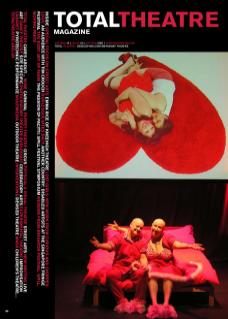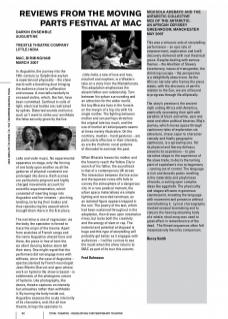In Augustine, the journey into the 19th-century La Salpêtrière asylum is experienced physically – the show starts with a breathing duet bringing the audience close to suffocation and unease. A man talks tenderly to encased violins, which, like him, have been committed. Confined in cells of light, electrical bodies are restrained by splints. Distorted sounds and lyrics such as ‘I want to strike you’ annihilate the false security given by the live cello and violin music. No experimental apparatus on stage, only the forcing of one body upon another as all the gestures of physical constraint are prolonged into dance. Bath scenes are particularly poignant and highly charged movements account for scientific experimentation, which consisted of inserting tongs into Augustine and her inmates – pinching, twisting, torturing their bodies and thus reproducing the assault which brought them there in the first place.
The narrative is one of regression: via the body, the spectator is forced to trace the origin of the trauma. Apart from snatches of French songs and the name Augustine uttered here and there, the piece is free of text: the six silent dancing bodies alone tell their story. One might regret that the performers did not engage more with stillness, since the case of Augustine – spectacularised by French neurologist Jean-Martin Charcot and upon whose work on hysteria the show is based – is emblematic of the photogenic nature of hysteria. Like photography, like dance, theatre captures an intensity but unleashes rather than withholds it. By turning the body inside out, Augustine exposes the acute interiority of its characters, and, like all true theatre, brings the spectator in.
Little India, a tale of love and loss, mischief and mayhem, is a Western take on a story from the Mahabharata. This adaptation emphasises the absent father-son relationship. Torn between his sylvan surrounding and an attraction for the wider world, the boy Bharata lives in the forests on the margin of a big city with his single mother. The fighting between mother and son perhaps stretches the original tale too much, and the use of martial art kalaripayattu seems at times merely illustrative. On the contrary, mudras – hand gestures – are particularly effective in their intensity, as are the rhythmic vocal patterns of Konnakol to summon the past.
When Bharata leaves his mother and the forest to reach the Yellow City in search of his father, the soundtrack is that of a contemporary UK street. The interaction between the live actor and the typecast voice-offs fails to convey the atmosphere of a dangerous city. In a rare poetical moment, the urban space materialises via simple lighting and recorded raindrops, as an isolated figure appears trapped in the rain. The poetry of the text, which had been sustained throughout in the adaptation, then draws upon streetwise rimes, but lacks both the creativity and the energy of slam or rap. The material and potential at disposal is huge and this type of storytelling will probably get better as it engages with audiences – I will be curious to see the result when the show returns to MAC as part of its tour this autumn.

